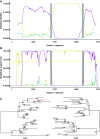Enterovirus D68 in Viet Nam (2009-2015)
- PMID: 28852711
- PMCID: PMC5553084
- DOI: 10.12688/wellcomeopenres.11558.2
Enterovirus D68 in Viet Nam (2009-2015)
Abstract
Background: Since 1962, enterovirus D68 (EV-D68) has been implicated in multiple outbreaks and sporadic cases of respiratory infection worldwide, but especially in the USA and Europe with an increasing frequency between 2010 and 2014. We describe the detection, associated clinical features and molecular characterization of EV-D68 in central and southern Viet Nam between 2009 and 2015.
Methods: Enterovirus/rhinovirus PCR positive respiratory or CSF samples taken from children and adults with respiratory/central nervous system infections in Viet Nam were tested by an EV-D68 specific PCR. The included samples were derived from 3 different observational studies conducted at referral hospitals across central and southern Viet Nam between 2009 and 2015. Whole-genome sequencing was carried out using a MiSeq based approach. Phylogenetic reconstruction and estimation of evolutionary rate and recombination were carried out in BEAST and Recombination Detection Program, respectively.
Results: EV-D68 was detected in 21/625 (3.4%) enterovirus/rhinovirus PCR positive respiratory samples but in none of the 15 CSF. All the EV-D68 patients were young children (age range: 11.8 - 24.5 months) and had moderate respiratory infections. Phylogenetic analysis suggested that the Vietnamese sequences clustered with those from Asian countries, of which 9 fell in the B1 clade, and the remaining sequence was identified within the A2 clade. One intra sub-clade recombination event was detected, representing the second reported recombination within EV-D68. The evolutionary rate of EV-D68 was estimated to be 5.12E -3 substitutions/site/year. Phylogenetic analysis indicated that the virus was imported into Viet Nam in 2008.
Conclusions: We have demonstrated for the first time EV-D68 has been circulating at low levels in Viet Nam since 2008, associated with moderate acute respiratory infection in children. EV-D68 in Viet Nam is most closely related to Asian viruses, and clusters separately from recent US and European viruses that were suggested to be associated with acute flaccid paralysis.
Keywords: Enterovirus D68; VIZIONS; Vietnam; next generation sequencing; respiratory infections.
Conflict of interest statement
Competing interests: No competing interests were disclosed.
Figures



References
Grants and funding
LinkOut - more resources
Full Text Sources
Other Literature Sources

